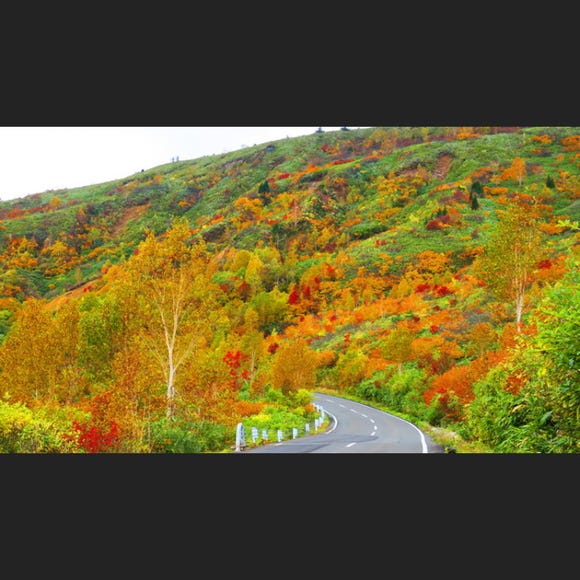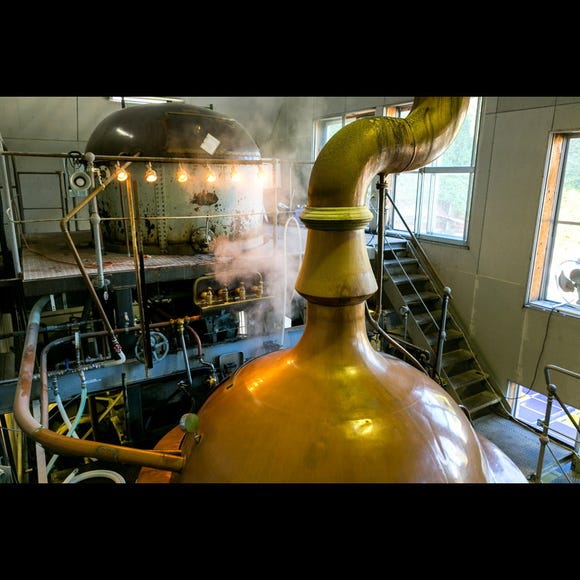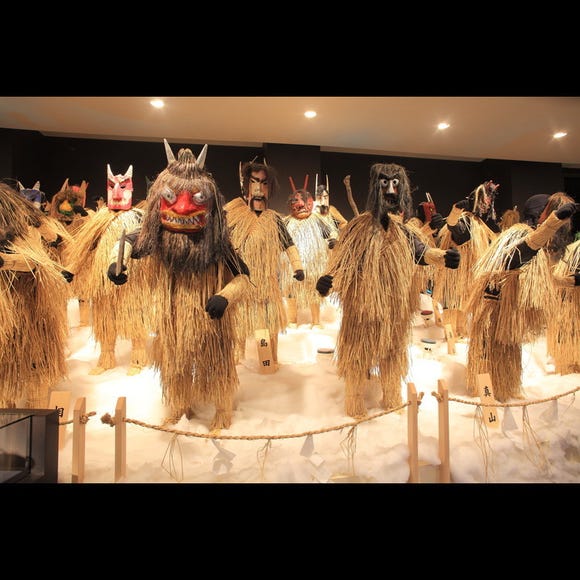
Winter transforms Japan’s Northeastern region of Tohoku into a breathtakingly beautiful white world, where mountain villages, hot springs, and historic towns take on a quiet, magical charm.
In this guide, discover the region’s most spectacular snow scenes—from the frost-covered trees of Zao and the frozen falls of Oirase Stream to the nostalgic lights of Ginzan Onsen. Whether you’re here for snow festivals, skiing, or a cozy ride on a stove train, these destinations promise unforgettable winter adventures in the heart of snowy Japan.
(Main image: PIXTA)
(This article contains affiliate links)
- Table of Contents
-
- Tohoku Winter Sightseeing Tips: Weather, What to Pack, Getting Around
- Recommended sightseeing and things to do in winter in the Tohoku Region
- 1. Miyagi: Snowy Japanese Castle, Islands and Other Winter Wonderlands
- 2. Aomori: Oirase Gorge, Stove Train, Shirakami-Sanchi, and Other Fantastic Snowy Worlds
- 3. Akita: Warm winter scenery, onsen hot springs and igloo festivals
- 4. Iwate: World Heritage Hiraizumi, Kenji Miyazawa's Fairytale Village, and other dreamy winter snowscapes
- 5. Yamagata: Romantic Ginzan Onsen, Magical 'Snow Monsters', Kamikawa Heated Boat Cruises
- 6. Fukushima: Fairytale atmosphere of Ouchijuku Village, Urabandai Lakes, Snowy Tsurugajo Castle, and more
Tohoku Winter Sightseeing Tips: Weather, What to Pack, Getting Around

Winter weather in Tohoku
Although the Tohoku region is located on Japan's Honshu Island, just like Tokyo and Osaka, it has a higher latitude and elongated geography, flanked by seas on both sides, resulting in a very cold winter climate. The snowfall patterns differ greatly between the Japan Sea side and the Pacific side. On the Japan Sea side, cold, dry continental winds absorb heat and moisture from the warm Japan Sea, forming snow clouds. This results in shorter daylight hours and more snowy days. On the Pacific side, as the winds cross the Ou Mountains, they become dry, leading to drier and sunnier conditions in the coastal and plain areas.
The autumn usually begins around October, with sporadic snowfall starting in November. December marks the onset of winter, with increased snowfall in the mountains and surrounding areas, and an average temperature of about 4°C (39°F). By January, heavy snow also starts to fall in the plains, with average temperatures around 1°C (34°F), necessitating thorough cold weather preparations. February continues the cold trend from January, with average temperatures around 2°C (36°F). During this period, not only is it cold, but the air is also very dry, so don't forget to carry hand cream and lotion to keep your skin happy.
Regarding the weather, the winters in Tohoku, similar to those in Hokkaido, are predominantly dry and cold, so there's usually no need to carry rain gear. Snowfall is common, but the snow in Tohoku is quite dry and crisp, so there's often no need for an umbrella; focusing on staying warm is key.
What to wear for the snowy season in Tohoku
When exploring the wintry Tohoku, staying warm is crucial, especially since many attractions are located in the mountains. Essentials include thermal wear, sweaters, thick jackets, and down coats – a hooded coat is handy for snowfall.
Gloves, beanies, and scarves are highly recommended; temperatures can drop below freezing, and exposed skin can sting in the wind and snow.
For footwear, sports shoes or flat boots are ideal. They should have good grip for snowy or icy surfaces, and waterproof material is advised as snow on shoes can melt quickly under sunlight or indoors.
If you're unsure about what to wear, take a look at our practical outfit suggestions to ensure you stay warm while enjoying the snow in Tohoku!
Getting around in winter in Tohoku
For traveling in Tohoku, the main ways of getting around are trains, buses, and rental cars.
The most convenient is the JR rail network, which is covered under the JR East Rail Pass. This pass not only makes travel to major stations in Tohoku easy, but it also covers almost all Shinkansen and train travel in the area. With a 5-day unlimited use, it can be a big money-saver if your itinerary is well-planned. Typically, reaching your destination involves getting off at the nearest station and then walking or taking a bus.
If you find public transportation inconvenient and are confident in your driving skills, self-driving around Tohoku, especially to remote mountainous areas, can be the most convenient option. However, driving in snow is challenging due to icy and snowy road conditions. Remember to use snow tires, avoid sudden movements, maintain a safe distance from other vehicles, slow down, and stay alert to road conditions. Following traffic rules diligently helps prevent accidents.
Recommended sightseeing and things to do in winter in the Tohoku Region
1. Miyagi: Snowy Japanese Castle, Islands and Other Winter Wonderlands

Miyagi, home to Sendai City, is often the first stop for many tourists in Tohoku. It's known for historical sites related to Date Masamune, such as Sendai Castle, the scenic Matsushima listed among Japan's three most scenic views, and the impressive Sendai Daikannon.
In winter, these sites, including the snow-covered Japanese castle, the islands in snow surrounded by sea, and the Kannon statue in snow, are exceptionally beautiful. Additionally, famous frost-covered trees can be admired in Miyagi, with ski resorts and accommodations available. In winter, the foxes at Miyagi Zao Fox Village become especially fluffy, transforming into adorable snow spirits amidst the snowfall.
In Sendai's city area and Matsushima, you can also enjoy romantic light decorations. These bright lights illuminate the world like stars at night, making the snowflakes in the air appear even more dreamlike and enchanting. Don't miss this beautiful scene when visiting Sendai in winter.
Recommended Snowy Spots in Miyagi
Recommended Winter Experiences and Events in Miyagi
2. Aomori: Oirase Gorge, Stove Train, Shirakami-Sanchi, and Other Fantastic Snowy Worlds

Adjacent only by a strait to Hokkaido, Aomori experiences severe cold in winter, offering numerous snow-related attractions. The renowned Oirase Stream, for instance, presents a rare view of ice waterfalls in winter, and the World Heritage-listed Shirakami Mountains turn into mystical snowy peaks. Waterside spots like the Tsuru-no-Mai Bridge are also dressed in snow. At the Aomori Prefectural Art Museum, the giant “Nara Yoshitomo Dog” statue looks adorable covered in thick snow.
Aomori features the special Tsugaru Railway stove train in winter, where you can enjoy the snowy landscape from the warmth of the train. For the adventurous, snowshoe trekking on Mount Hakkoda is a must.
The Hirosaki Castle and Lake Towada in Aomori host engaging festivals like the "Snow Lantern Festival" and "Towada Winter Story," with illuminations in the evening, making these sites highly recommended for visitors.
Recommended Snowy Spots in Aomori
Recommended winter activities and festivals in Aomori
3. Akita: Warm winter scenery, onsen hot springs and igloo festivals

Akita, renowned for its spring cherry blossoms and autumn foliage, has a unique charm in winter. Highlights include the stark contrast between the black walls of the Kakunodate Samurai District and white snow, the deeply snow-covered Tazawako Lake, and the magical ice pillars of Oyasukyo. You can even enjoy a snowy stroll with the adorable Akita dogs. Akita is famed for its hot springs, especially Nyuto Onsen in winter, a favorite among tourists and a must-visit for onsen lovers.
Winter in Akita also brings festivals like the "Kamakura Fire and Snow Hut Festival" and the Yokote Snow Hut Festival. The former, a harvest festival in Kakunodate, features participants swinging fireballs at night to illuminate the world. The latter, held in Yokote City, displays rows of small snow huts, each with a candle inside, creating a warm, spirit-like glow that touches the hearts of visitors. Both are highly worth experiencing.
Recommended snowy spots in Akita
Recommended winter activities and festivals in Akita
4. Iwate: World Heritage Hiraizumi, Kenji Miyazawa's Fairytale Village, and other dreamy winter snowscapes

Iwate, a beautiful hidden gem with ethereal natural landscapes, features sites like Chusonji in Hiraizumi, a World Heritage Site, and the otherworldly Jodo no Hama. In winter, these spots create ink-painting-like scenes with crisp air and white snow. The scenic Geibikei Gorge, beautiful in all seasons, offers special kotatsu boat rides in winter, allowing close-up views of the snowy valley in warmth. Additionally, the "Miyazawa Kenji Fairy Tale Village," themed after works of a great Japanese literary figure, turns into a real-life fairy tale world under snow. After taking photos outdoors, visitors can enjoy indoor exhibits, making it perfect for families.
A winter must-visit in Iwate for tourists is the Sanriku Railway's "Stove Train." Not only does it bring the warmth of a stove onto the train, but it also offers guided tours, local bento boxes, commemorative ride certificates, and even a glimpse of Iwate's Namahage, making for a fun and unique experience!
Recommended snowy spots in Iwate
Recommended winter activities and festivals in Iwate
5. Yamagata: Romantic Ginzan Onsen, Magical 'Snow Monsters', Kamikawa Heated Boat Cruises

Yamagata Prefecture's winter sights are extremely popular, with its natural areas, temples and shrines looking more magnificent and sacred under a blanket of snow. The most famous among these is Ginzan Onsen, reminiscent of the mystical setting from the movie 'Spirited Away'. In winter, Ginzan Onsen exudes a romantic Taisho-era ambiance, with every corner offering a charming atmosphere. The renowned 'Zao Frost Covered Trees' in Yamagata are a must-see winter spectacle, and after enjoying the frost-covered trees and skiing, you can head directly to Zao Onsen to relish the pleasure of a hot spring bath.
For a closer encounter with Yamagata’s natural beauty, take a kotatsu boat ride on the Mogami River. The contrast between the warmth enveloping you and the snowy river landscape offers a fascinating and enjoyable experience.
Recommended snowy spots in Yamagata
Recommended winter activites and festivals in Yamagata
6. Fukushima: Fairytale atmosphere of Ouchijuku Village, Urabandai Lakes, Snowy Tsurugajo Castle, and more

In Fukushima during winter, the top destination is the thatched-roof village of Ouchi-juku, where rows of thatched houses are covered in thick, frosting-like snow, creating a scene straight out of a fairy tale. It's quaint and charming, drawing many tourists and photography enthusiasts. Other natural spots like Ura-Bandai, a collection of lake communities, and Lake Inawashiro, known as Swan Lake, are must-see winter beauties in Fukushima. For those who appreciate the rustic and mystical beauty of traditional Japanese architecture in the snow, a visit to the uniquely shaped Aizu Sazae-do or the snow-capped Tsuruga Castle is recommended, offering a tranquil experience of Japan’s history in the cold of winter.
Recommended snowy spots in Fukushima
Recommended winter activities and events in Fukushima
- Area
- Category
*Prices and options mentioned are subject to change.
*Unless stated otherwise, all prices include tax.
Popular Tours & Activitiess
Recommended places for you
-

Matsushima Bay
Landscapes
Sendai And Matsushima
-

Hachimantai Aspite Line
Landscapes
Morioka, Hiraizumi And Hachimantai
-

Baeren Brewery Co., Ltd.
Other Sightseeing
Morioka, Hiraizumi And Hachimantai
-

Aomori Museum of Art
Art Museums
Aomori, Hirosaki And Hachinohe
-

Namahage Museum
Other Museums
Surrounding Areas Of Akita
-

Hirosaki Park
Parks
Aomori, Hirosaki And Hachinohe
-

Shopping in Akita: 11 Must-Buy Souvenirs & Where to Shop Near the Station and Airport
by: ShiroKu inc.
-
Ad

Just one stop from Haneda Airport! "Truly Japanese!" Food, Fun, and Knowledge Gather at HICityⓇ Enjoy An Electrifying Night at "Japan Night Fever: Haneda Innovation City"
by: Yohei Kato
-

Niigata Sake no Jin 2026: Guide to Japan's Most Legendary Sake Weekend
-

Dining in Yamagata: Must-Try Foods & Top Restaurants Near the Station
by: ShiroKu inc.
-

What to Buy in Aomori? 11 Aomori Souvenirs Locals Actually Recommend
by: ShiroKu inc.
-

Shopping in Niigata: 9 Must-Buy Souvenirs & Local Sake to Take Home
by: ShiroKu inc.
-

Yokote Kamakura Snow Festival 2025: Enjoy Cool Snow Huts in Akita Prefecture This Winter
by: Ran Tanaka
-

Pure, Untouched Winter in Japan – 10 Spots to Enjoy the Wonders of Tohoku in Winter
-

Explore Tohoku in Winter With 5 Budget-Friendly Travel Passes (Local Recommended!)
by: Masakazu Yoshida
-

9 Things to Do in Aomori in Winter - Japan’s Deep Snow Country
-

Best Outlet Malls Near Sendai: Shopping, Souvenirs, and Discounts
-

JR Edition: Visit all of Tokyo in one Day with the Tokyo Metropolitan District Pass!






































































